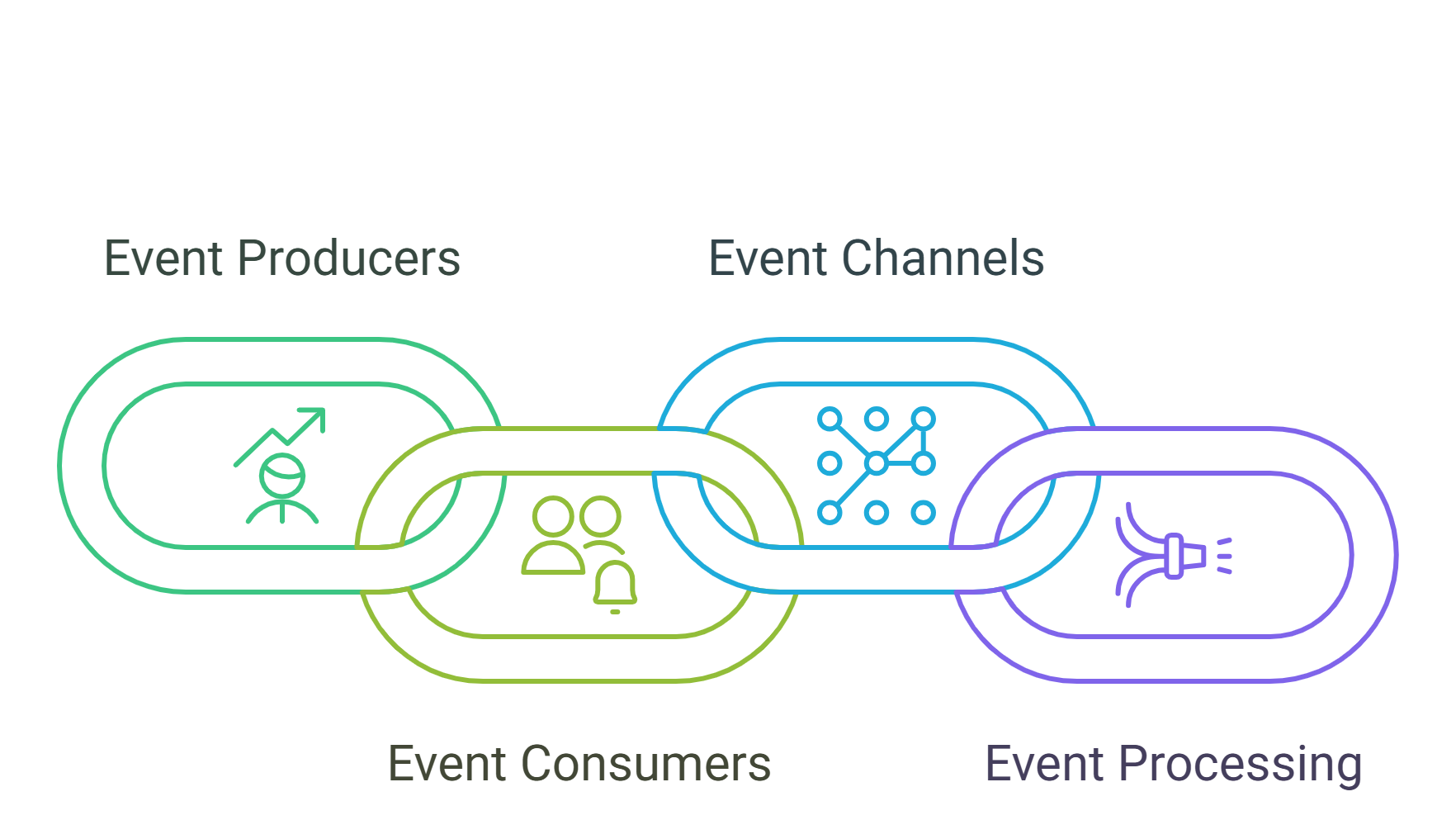
Event-Driven Architecture in App Development is transforming how modern applications are designed, built, and delivered. With digital products evolving to serve millions of users, traditional architectures often fall short in responsiveness and efficiency. In contrast, Event-Driven Architecture (EDA) allows applications to react instantly, handle large volumes of data smoothly, and seamlessly integrate with diverse systems. This approach is especially critical in today’s environment where businesses demand real-time insights, flexible scalability, and improved customer engagement.
In this article, we will explore what Event-Driven Architecture in App Development means, how it works, its advantages, core components, business benefits, a practical case study, and finally answer some frequently asked questions to guide developers and enterprises toward adoption.
Understanding Event-Driven Architecture in App Development
Event-Driven Architecture in App Development is a design paradigm that focuses on the detection, production, and reaction to events. An event refers to any significant change in the state of an application, such as a user clicking a button, a sensor sending temperature data, or an order being placed in an e-commerce system. Unlike traditional request-response models, where communication is tightly coupled, EDA offers a more asynchronous and decoupled approach.
This architecture is particularly effective because it enables real-time responsiveness. Instead of waiting for periodic checks or static processes, applications react instantly to the events they receive. As a result, user experiences become smoother, business processes become more adaptive, and systems become highly scalable.
Core Components of Event-Driven Architecture in App Development

To fully leverage Event-Driven Architecture in App Development, it is essential to understand its core building blocks:
Event Producers
Event producers generate data when a state change occurs. For instance, an online marketplace system might generate an event when a user places an order. The event details could include the user ID, product ID, order time, and payment confirmation.
Event Consumers
Event consumers listen, subscribe, or react to these events. Depending on the application’s needs, consumers could trigger further workflows, notifications, automated reports, or even machine learning models.
Event Channels or Brokers
Events do not move directly from producers to consumers. Instead, Event Brokers or Middleware systems manage communication. Popular technologies like Apache Kafka, RabbitMQ, or cloud-native services like AWS EventBridge act as orchestrators. They route events efficiently to the right consumers.
Event Processing
Applications using EDA often implement event processing logic. This can be simple event forwarding or complex event processing (CEP), where events are aggregated, filtered, and analyzed in real-time to derive actionable insights.
Why Event-Driven Architecture in App Development Matters
Transitioning from traditional synchronous architectures to an event-driven approach offers multiple benefits, aligning perfectly with modern business goals.
Scalability
Event-Driven Architecture in App Development allows applications to scale horizontally with ease. Since events are decoupled, producers and consumers can operate independently without direct dependencies. This independence supports handling massive spikes in user traffic.
Real-Time Responsiveness
Businesses today demand instant responsiveness. With EDA, events are processed in near real time. A financial trading app, for instance, can instantly react to market fluctuations without relying on periodic updates.
Improved Fault Tolerance
Failure in one component does not cascade into others because the system is decoupled. Event brokers buffer messages, making applications more fault-tolerant and resilient during outages.
Flexibility and Adaptability
Enterprises can add new event consumers without disrupting existing workflows. This adaptability makes Event-Driven Architecture in App Development a perfect fit for evolving digital ecosystems.
EDA vs Traditional Request-Response Architectures
| Feature | Event-Driven Architecture in App Development | Traditional Request-Response |
|---|---|---|
| Coupling | Loosely coupled | Tightly coupled |
| Responsiveness | Real-time reaction to events | Delayed checks or polling |
| Scalability | Flexible and horizontal | Limited vertical scaling |
| Fault Tolerance | Failures isolated with brokers | Failures cascade across layers |
| Use Cases | IoT, real-time analytics, messaging apps | Simple applications, legacy systems |
Use Cases of Event-Driven Architecture in App Development
Event-Driven Architecture is adaptable across industries and application types.
- E-commerce platforms: Instant order confirmations, inventory updates, and real-time shipment tracking.
- IoT applications: Smart devices sending and processing millions of sensor data per second.
- Financial services: Fraud detection, online payments, and stock market monitoring.
- Healthcare applications: Patient monitoring with wearable devices enabling immediate alerts to doctors.
- Social media platforms: Notification systems, content recommendation engines, and messaging services.
These examples demonstrate how versatile EDA can be in addressing today’s digital challenges.
Case Study: E-Commerce App Leveraging Event-Driven Architecture
An online retail enterprise faced a challenge of handling millions of user interactions daily while ensuring seamless order processing and customer experience. Their traditional monolithic system relied on periodic database checks, leading to delays, poor scalability, and occasional downtime during peak hours.
Solution Implemented with EDA:
- Order Placement as Events: Each time a customer placed an order, an event was generated with all transactional details.
- Event Broker for Distribution: The events were routed through Apache Kafka. This broker managed data flow efficiently, ensuring the right services consumed the information.
- Independent Consumers: Separate services subscribed to events: one handled inventory management, another managed payment processing, while a third triggered shipment initiation.
- Real-Time Notifications: Consumers integrated with a push notification service so customers immediately received confirmation and delivery notifications.
- Scaling with Demand: During flash sales, the system scaled effortlessly by adding more event consumers without halting the application.
Results Achieved:
- Order processing time reduced by 65%.
- System handled traffic spikes three times larger than before without downtime.
- Customer satisfaction scores improved significantly with real-time updates.
- Developers added new microservices within weeks without disrupting existing operations.
This case study strongly validates that Event-Driven Architecture in App Development delivers tangible improvements in scalability, user experience, and operational efficiency.
Best Practices in Implementing Event-Driven Architecture
- Design events carefully: Define events with meaningful names and standardized formats.
- Ensure idempotency: Consumers should handle repeated events gracefully.
- Use a reliable broker: Choose a robust event streaming platform with proven performance.
- Implement monitoring: Monitor event flows to identify bottlenecks.
- Adopt microservices: Break down complex apps into consumer-producer microservices for flexibility.
Future of Event-Driven Architecture in App Development
With technologies like 5G, IoT, and edge computing shaping the digital landscape, Event-Driven Architecture will play an even bigger role. By powering real-time smart cities, predictive analytics, immersive gaming platforms, and AI-driven automation, EDA offers a sustainable path to future-proof applications.
FAQs
1. What is Event-Driven Architecture in App Development?
Event-Driven Architecture is a design model where systems respond to state changes, known as events. It enables real-time responsiveness, decoupling services, and scalable system design.
2. Why should I use Event-Driven Architecture instead of traditional models?
Unlike traditional request-response systems, EDA offers scalability, agility, and fault tolerance. It allows businesses to react instantly, making user experiences seamless.
3. Does EDA work better with microservices?
Yes. EDA complements microservices well by allowing individual services to communicate asynchronously through events, preserving independence and resilience.
4. What challenges come with implementing EDA?
While EDA offers multiple benefits, challenges include complex debugging, ensuring idempotency, and choosing the right event broker. Careful design and monitoring overcome these hurdles.
5. Can existing apps be migrated to Event-Driven Architecture?
Yes. Companies often transition in stages by introducing event-driven microservices alongside legacy systems, eventually moving fully to EDA.

